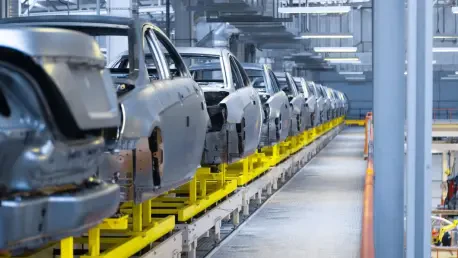Overview of the Canadian Automotive Landscape
The Canadian automotive industry stands at a critical juncture, grappling with a seismic shift as Stellantis NV, a global automaker, plans to relocate production of the Jeep Compass from Brampton, Ontario, to Illinois, USA. This decision has sent shockwaves through a sector that employs tens of thousands and contributes significantly to national prosperity, particularly in Ontario, which accounts for 40% of Canada’s GDP. With the stakes higher than ever, this development raises pressing questions about the future of manufacturing in the region and the government’s ability to safeguard vital economic interests.
Beyond the immediate concern of job losses, the situation underscores a broader challenge within an industry that has long been a pillar of Canadian economic stability. Historically, the sector has benefited from substantial government support, including financial incentives and policy frameworks designed to keep production domestic. As global pressures mount, understanding the dynamics at play reveals not just a corporate decision, but a test of national resilience and strategic policymaking in an interconnected market.
Detailed Analysis of the Stellantis Decision
Economic Significance and Regional Impact
The Canadian automotive industry, centered in Ontario, serves as an economic engine, with plants like Stellantis’ Brampton facility playing a pivotal role. This plant, responsible for producing the Jeep Compass, supports thousands of direct and indirect jobs, from assembly line workers to suppliers across the supply chain. A potential shift in production threatens not only these livelihoods but also the broader economic fabric of communities reliant on steady employment and industrial activity.
Moreover, the ripple effects extend beyond immediate job cuts, impacting local businesses and tax revenues that fund public services in the region. Ontario’s contribution to national GDP amplifies the gravity of this move, as any downturn in industrial output could have cascading consequences for economic growth. Policymakers face mounting pressure to address these risks, balancing corporate autonomy with the urgent need to protect domestic interests.
Political Reactions and Government Stance
The decision by Stellantis has ignited a firestorm of political backlash, with Canadian leaders uniting in opposition. Minister of Industry Melanie Joly has issued a stern warning to Stellantis CEO Antonio Filosa, indicating that failure to honor prior commitments tied to government support could result in legal repercussions. This firm stance reflects a broader sentiment of betrayal felt across political aisles, as leaders prioritize accountability.
Prime Minister Mark Carney has echoed this resolve, emphasizing the government’s expectation that Stellantis upholds promises made to Canadian workers. Meanwhile, Ontario Premier Doug Ford has taken to public platforms to voice personal disappointment, highlighting the emotional toll on communities tied to the Brampton plant. This unified front signals a readiness to escalate measures if negotiations falter, underscoring the political sensitivity of industrial policy.
Stellantis’ Strategic Rationale
From Stellantis’ perspective, the relocation of Jeep Compass production aligns with a broader $13 billion investment in the US market, aimed at expanding capacity and launching five new models. This strategic pivot is driven by the need to capture a larger market share and adapt to evolving consumer demands in a competitive landscape. The Illinois facility offers logistical advantages and proximity to key markets, justifying the shift in corporate eyes.
Spokesperson LouAnn Gosselin has attempted to mitigate concerns by reaffirming Stellantis’ commitment to Canada, pointing to plans for a third shift at the Windsor, Ontario plant. However, ambiguity surrounding the future of the Brampton facility persists, leaving stakeholders anxious for concrete reassurances. This balancing act between global expansion and local obligations illustrates the complex calculus facing multinational corporations.
External Factors Complicating the Situation
Adding to the tension are external pressures, notably US tariffs on Canadian goods announced by President Donald Trump, which have disrupted the integrated North American auto industry. These trade barriers have introduced uncertainty, affecting cost structures and supply chain dynamics that automakers like Stellantis rely upon. The resulting economic friction has compounded challenges for maintaining production in Canada.
Additionally, Stellantis’ decision to pause retooling efforts at the Brampton plant earlier this year reflects the broader instability caused by such geopolitical shifts. This hiatus not only delays potential upgrades but also signals a lack of long-term confidence in the facility’s role within the company’s portfolio. Navigating these external headwinds remains a critical hurdle for both corporate planners and Canadian authorities.
Tensions Between Corporate Goals and National Priorities
The standoff with Stellantis encapsulates a recurring theme in the global auto industry: the clash between corporate strategies focused on profitability and national interests centered on job preservation. As companies like Stellantis pursue growth through international investments, governments grapple with the fallout of reduced domestic manufacturing. This dynamic reveals the fragility of partnerships built on mutual economic benefit.
In Canada’s case, the situation highlights the challenge of enforcing commitments in a globalized economy where corporate decisions often transcend borders. The outcome of this dispute could set a precedent for how future agreements with multinational firms are structured, influencing policy approaches to industrial retention. Bridging this divide requires innovative solutions that align business imperatives with societal needs.
Reflections and Path Forward
Looking back, the discourse surrounding Stellantis’ decision revealed deep-seated concerns about economic stability and the efficacy of government intervention in corporate affairs. The unified opposition from Canadian leaders underscored a collective determination to protect industrial capacity, while Stellantis’ responses highlighted the complexities of multinational operations. This clash illuminated the broader struggle to maintain national relevance in a fiercely competitive global market.
Moving forward, actionable steps emerged as a focal point for resolution. Negotiations between Stellantis and Canadian officials should prioritize a clear roadmap for the Brampton facility, potentially exploring alternative production lines or investment incentives to retain jobs. Collaborative frameworks that incentivize corporate responsibility while accommodating growth strategies could pave the way for a sustainable compromise. Ultimately, fostering dialogue and mutual understanding stands as the most viable approach to safeguarding Canadian interests without stifling corporate innovation.









